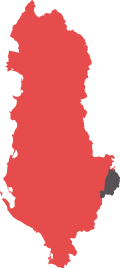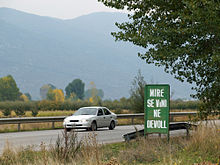Devoll community
|
Devoll Devolli |
||

|
||
|
Coordinates: 40 ° 37 ' N , 20 ° 59' E |
||
| Basic data | ||
|---|---|---|
| Qark : | Korça | |
| Municipality : | Devil | |
| Area : | 453.27 km² | |
| Bashkia residents : | 26,716 (2011) | |
| Population density (Bashkia): | 59 inhabitants / km² | |
| Telephone code : | (+355) 0811 | |
| Postal code : | 7006 | |
| Politics and administration (as of 2019 ) | ||
| Mayor : | Kristo Kiço ( PS ) | |
| Website : | ||
 Location of the community of Devoll |
||
The municipality of Devoll ( Albanian Bashkia e Devollit ) is one of the 61 municipalities in Albania . The area of the municipality with an area of 429 square kilometers in Qark Korça corresponds to the former district of Devoll . According to the census, the community has 26,716 inhabitants (2011). The main town is the small town of Bilisht .
geography
Devoll is located in the very south-east of the country. The easternmost point of Albania is not far from the Kapshtica border crossing . The entire eastern and southern municipal border is also the national border with Greece . Neighboring communities in the west and north are the communities Kolonja , Korça , Maliq and Pustec .
The community is located in the high valley of the Devoll River , which has its source in the southwest of the area . Bilisht lies at an altitude of around 900 m above sea level. A. on a plain surrounded by mountains on almost all sides. The border crossing Kapshtica to Greece is 1048 m above sea level. A. high pass . The western boundary of the district is formed by the mountain range of the Malet i Moravës with the peak Maja e Lartë ( 1806 m above sea level ), on the other side of which lies the town of Korça. There are only three passages between the mountains. In the northwest, the Devoll flows through a narrow pass into the plain of Korça . In the northeast, the long arm of the Little Prespa Lake stretches almost into the plain of Bilisht. In the southeast, the plain drops almost seamlessly into the gorge of the Kore River , which meanders through the mountains here. This river, which flows into the Aliakmonas , makes a loop about five kilometers long through Albanian territory. The few square kilometers drained by it are the only area of Albania that does not belong to the catchment area of the Adriatic or Ionian Sea , but to the catchment area of the Aegean Sea .
The Bilisht Plain was made usable thanks to numerous drainage channels. When there was heavy rainfall and in spring when the snow melted, water flowed naturally from the Kleiner Prespa Lake into the Devoll and thus directly into the Adriatic. From the 1950s to around 2000, the Devoll was also diverted into the Kleiner Prespa Lake during floods. The water stored in this way was used to irrigate the Korça plain .
In the mountains east of Bilisht along the border with Greece, extensive nickel deposits are suspected.
history
Cave paintings from the Iron Age (near Tren ) and graves with jewelery from the Illyrians (near Kuç ) have been found in the municipality . The chapel in the Blashtonja cave on the Little Prespa Lake dates from the 13th century . The cave paintings are the oldest works of art found in Albania and some of the icons from the chapel are among the oldest of their kind in the country.
Before the Second World War, the Devoll-Hochtal was an independent administrative district. During the socialist era, the region belonged to Korça County, from which it was separated again during the territorial reform of 1990 . During the territorial reform of 2015, the municipalities of the Devoll district were merged into the new municipality of Devoll.
economy
The Kapshtica border crossing is one of the most important road connections to Greece. Accordingly, the whole region, which is isolated from the rest of Albania, is also oriented towards Greece and border traffic. In the otherwise heavily agricultural area, numerous services for travelers were developed. In particular, many young men from the region worked mostly illegally in Greece in the 1990s to escape poverty at home. In the meantime, many have managed to bring their families to join them.
Former parishes
In summer 2015, the following municipalities were merged to form the municipality of Devoll :
| Surname | Residents | Community type |
|---|---|---|
| Bilisht | 6,250 | Bashkia |
| Hoçisht | 4,461 | Komuna |
| Miras | 6,577 | Komuna |
| Progër | 3,988 | Komuna |
| Qënder Bilisht | 5,440 | Komuna |
literature
- Gilles de Rapper: pushing boundaries. Migration in the Albanian border region of Devoll . In: Karl Kaser, Robert Pichler, Stephanie Schwander-Sievers (eds.): The wide world and the village. Albanian emigration at the end of the 20th century = To the customer of Southeast Europe: Albanological studies . tape 3 . Böhlau-Verlag, Vienna 2002, ISBN 3-205-99413-2 .
- Gilles de Rapper: Religion in Post-communist Albania - Muslims, Christians and the idea of 'culture' (Devoll, Southern Albania) . In: Anthropological Notebooks . tape 14 (2) , 2008, p. 31–45 ( article at HAL [PDF; 185 kB ]).
Individual evidence
- ↑ a b Ines Nurja: Censusi i popullsisë dhe banesave / Population and Housing Census - Korçë 2011 . Results Kryesore / Main Results. Ed .: INSTAT . Pjesa / Part 1. Adel Print, Tirana 2013 ( instat.gov.al [PDF; accessed April 14, 2019]).
- ↑ European Nickel says Devolli site in Albania resource estimate 426,775 tonnes. In: London South East. November 22, 2007, accessed on August 10, 2015 (English): "… two main deposits, Verniku and Kapshtica West."




